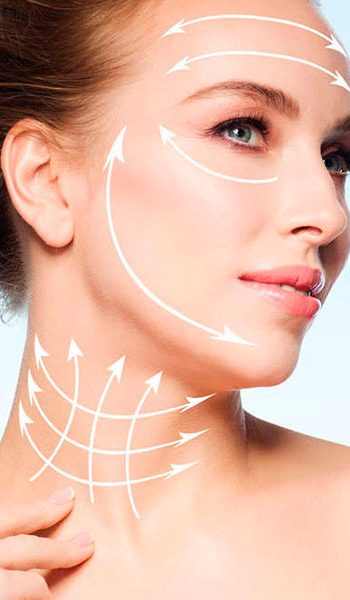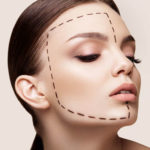

There are a variety of surgical procedures that can be performed to correct and improve some areas of the face with which the patient does not feel comfortable or simply want to enhance to give a more aesthetic touch to the face. Among these we can mention:
Also known as Rhytidectomy, it is a cosmetic surgery designed to improve the visible signs of aging on the face and neck. Since as we age, the skin and muscles of the face lose tone, with this intervention it is possible to stop this deterioration and improve the most evident signs of aging.
The facelift treats the deeper structures of the facial and neck tissues, and removes the selected areas of fat. It can be done in isolation or as a complement to other treatments or interventions, such as eyelid surgery. The lifting can be done with general anesthesia or local anesthesia. The choice will depend on the surgery that is going to be performed and the patient’s wishes.
Also known as forehead lift, it can give the patient a younger, fresher look by smoothing the forehead, reducing frown lines and elevating the position of the eyebrow line. The eyebrow lifting requires a relatively short recovery time and in general patients experience minimal discomfort.
Candidates for an eyebrow lift:
Healthy adults who have a positive body image are the best candidates for an eyebrow lift. The eyebrow lift can smooth fine lines and folds, raise the forehead, reposition the line of the eyebrows and lift and remove excess skin from the forehead that has lost its elasticity over the years. The eyebrow lifting will make you look much younger, but it will not radically change his appearance.
Known as eyelid surgery, it is a procedure to remove fat and excess skin and muscle from the upper and lower eyelids. The blepharoplasty can correct the fall of the upper eyelids and lower bags, characteristics that make us look older and more tired than we are and that, in some cases, can interfere with vision. However, blepharoplasty does not eliminate “crow’s feet” or other wrinkles or drooping of the eyebrows. It can be done in isolation or together with other cosmetic surgeries of the face, such as the cervicofacial lifting or the frontal lifting.
Who is the ideal candidate to undergo blepharoplasty?
The ideal candidates are those people who seek improvement, and not absolute perfection in their appearance. If you have a good general state of health, have psychological stability, and are realistic in your expectations, you will be a good candidate. Patients are usually 35 years old or older, but in some cases with a family tendency to have bags, patients are younger.
If you are considering a blepharoplasty, consult your plastic surgeon for basic information about the surgery, when it is indicated, how it is performed and what results can be expected.
Facial implants are used to improve facial contours. Frequently these implants help to give a more harmonious balance to your facial features so that you feel better with your appearance.
There are many implants available, made with a wide variety of materials. These implants can straighten the line of the jaw, advance a chin or cheekbones, helping to balance the rest of the face.
What can we expect from a facial implant?
Facial implants can improve your appearance and self-esteem. If you are looking for an improvement of your appearance and your expectations are realistic, then the realization of a facial implant may be the right choice.. We usually use these implants to obtain a better balance of the features of a young patient. For example, a teenager may need to reshape her nose and slightly advance her chin to make her features more proportionate. More mature patients generally use the implants in conjunction with other treatments. For example, during a facelift implants placed on the cheekbones contribute to a more youthful appearance. Implants can also be used to improve faces that look sad or tired.
Rhinoplasty is surgery that modifies the shape of the nose, and is one of the most frequently performed surgical procedures in plastic surgery. Rhinoplasty can decrease or increase the size of the nose, change the shape of the tip or back, narrow the nostrils or change the angle between the nose and the upper lip. It also corrects congenital problems, injuries and some respiratory problems.
This surgery is usually done under general anesthesia, but it can be done under local anesthesia, especially in nasal tip surgery. The incisions can be inside the nose in the nasal mucosa or in the columella. Through this the bone and cartilaginous structure of the dorsum and the structures of the septum can be modified, as well as the nasal tip. If any functional correction is required, the treatment of the nasal septum and / or turbinates will be carried out through the same incisions. The surgery is usually performed on an outpatient basis and lasts approximately 2-4 hours depending on the case.
This surgery can be combined with interventions of the jaws and / or placement of chin prostheses.
The best candidates for Rhinoplasty or nose surgery are those who understand their biotype and seek to improve their appearance without demanding perfection or altering their ethnic appearance. It is important to understand that if the skin of the nasal tip is thick it can be improved, but it can not be made extremely delicate without injuring it and causing greater damage.
The chin augmentation, also known as mentoplasty, which must be corrected a few centimeters, can be carried out by the following procedures:
- Implantation of a chin prosthesis, which can be made of different materials, such as solid silicone, Goretex®, etc. To insert the implant, it is possible to use an incision located inside the mouth, in the groove between the gum and the lower lip (intraorally), or a small incision in the skin below the chin, similar to the one used in the lower 1/3 Lifting or neck (external).
- Infiltration of fatty tissue from the patient using the Liposculpture technique, with permanent results.
- Advancement of a portion of bone of the jaw, through the sections of the bone (osteotomies) horizontal, also using the intraoral route. In these cases the edge of the bone is displaced and immobilized in an exact and precise way, allowing to correct the defect and if necessary it is also possible to conveniently shorten a face that is too long.
The increase of a chin that must be corrected to a greater degree, should be treated by bone sections or vertical advance osteotomies. When the preoperative assessment also shows a bad occlusion of the teeth that advises an advancement of the lower dental arch, an advance of the jaw will be necessary, with subsequent treatment of the orthodontist.
Also known as stretching of the tissues of the neck, is intended for lifting, reshaping and stretching of the tissues of the lower third of the face, which by constitution or aging are bulky, lax or descending. The cervicoplasty seeks to improve the facial contour, define the mandibular rim, decrease the nasolabial and puppet grooves, in addition to eliminating the excess neck flaccidity producing a long-term natural facial rejuvenation.
Neck surgery or cervicoplasty is performed under general anesthesia through discrete incisions in the temple and around the ear that coincide with the natural grooves making them imperceptible. With the exclusive cervicofacial technique, the entire skin of the neck and lower and middle third of the face is released, as well as a decrease in the subcutaneous fat layer at the neck. Through sutures, a correction and suspension of the platysma muscle of the neck is made in order to recover its tone and function as a support for the tissues of this area. The submandibular glands are also resected when they are prominent, and the deep layers of the middle and lower third of the face are stretched to improve the nasolabial and marionette grooves.
It is a procedure to correct multiple auricular deformities. The most frequent focuses on the ears on the screen, characterized by an increase in the angle between the ear and the scalp.
The ear has a constant growth from birth to 6 to 7 years. For this reason it is preferred to perform surgery in this period of life because it avoids the patient the psychological trauma that generates the mockery of their peers. However, it can be done in adulthood.
Usually this ear surgery requires incisions in the back of the ear, although incisions or approaches can be made in the anterior part. This allows the exposure of the auricular cartilage for modification with relaxation incisions and / or placement of fixation points. This surgery can be done with local OR general anesthesia lasting the surgery between 2 to 4 hours.
The surgery aims to modify the position of the ear with respect to the skull, but it is important to leave a margin of separation that allows cleaning and the use of glasses comfortably.
Who is the ideal candidate to undergo an otoplasty?
Most plastic surgeons recommend that parents observe the child’s behavior in relation to their prominent ears; Do not insist on surgery until the child so wishes. Those children who are displeased with their ears and want to have surgery, cooperate more during the intervention and are happier with the result.
Many patients, children or adults, may be unsure about the outcome of otoplasty. Keep in mind that you want to get an improvement, not absolute perfection. Do not expect an exact symmetry, which would even be unnatural. If you discuss with your plastic surgeon, the procedure, your expectations and options, the results will be very satisfactory.




